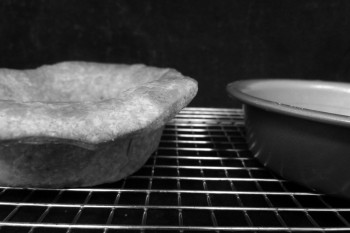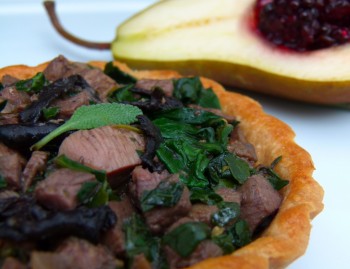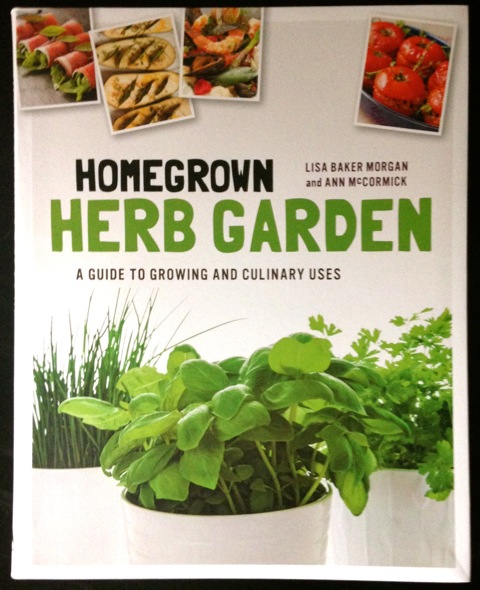duck, duck, tart:
duck and kale savory tartlet with black chanterelles, fresh sage and thyme
“Duck, duck, goose…” On a recent return from France I sat next to a man from Toulouse and our conversation began by discussing ducks and geese, although in the culinary-sense, not related to the childhood game. It was an natural topic of conversation because Toulouse is well-known for its ducks and geese and boasts regional specialities such as foie gras, cassoulet, and garbure. The temperature has finally caught up with the calendar and everyone is craving comfort food. My transatlantic conversation (and the fact that it is duck season) inspired this week’s simple pleasure: duck and kale savory tartlets with black chanterelles, fresh sage, and thyme. Comfort food, redefined.
Chicken pot pie is one of those comfort foods that both adults and children enjoy (some adults even sing about it). After all, what is not to like? Chicken with sweet carrots and peas swimming in béchamel sauce and encased in pie crust. This week’s simple pleasure is a seasonal and healthier take on this classic with all the flavor.
The tartlet combines sweet duck meat with healthy dark leafy greens (kale and spinach) and black chanterelle mushrooms. The crust is made with chestnut flour and freshly ground nutmeg. Rather than using béchamel sauce, the tartlet filling is bound with a flavorful red wine reduction that uses no flour or butter. This tartlet is an ideal first course for the holidays because it is full of the flavors that remind us of the season (woodsy mushrooms, fresh thyme and sage, citrus, nutmeg, cinnamon, and chestnuts).
People sometimes shy away from preparing duck; however, duck can be one of the easiest meats to cook if you remember the mantra: “low and slow.” This week’s recipe is long, not because it is difficult, but because you need to make both the crust and the filling. I was very specific in how to do that and if you follow the recipe and you will not have a problem and the duck will be perfectly prepared.
The tartlets can be made with or without a top crust and I have written the recipe both ways. The addition of the top crust makes the tartlet more substantial and if served with a salad or a small soup, it can be a main course. However, remember that the addition of a top crust requires an extra step and more dough (yielding less tartlets).
Chicken pot pie revisited just in time for the holidays. Of course, if you do not want to use duck, you can substitute turkey or chicken (and switch out the beef broth for chicken or turkey broth). However, wouldn’t it be fun (and delicious) to stay in the season and try something new? Duck, duck, tart …
Je vous souhaite un bon appétit !
LM
duck and kale savory tartlets
with black chanterelles, fresh sage, and thyme
stats:
yield:
4 covered tartlets (3” wide and 1 ¼” deep)
or 6 uncovered tartlets (3” wide and ¾½” deep)
what you need:
chestnut pâte brisée
½ ounce chestnut flour, sifted
7 ounces unbleached all-purpose flour, sifted
½ teaspoon kosher salt
½ teaspoon freshly ground nutmeg
pinch ground allspice
4 ounces unsalted butter, very cold
1 large egg, mixed
1 teaspoon cold water
red wine reduction
1 teaspoon water
½ teaspoon arrowroot
½ cup dry red wine
1 cup beef stock
1 bouquet garni (1 leek skin, 1 bay leaf, 4-5 fresh thyme sprigs)
duck tartlet filling
2 duck boneless breasts
kosher salt (as needed)
freshly ground pepper (as needed)
1 ½ tablespoons rendered duck fat
3 tablespoons minced shallots
¼ teaspoon freshly ground nutmeg
⅛ teaspoon ground cinnamon
½ teaspoon fresh thyme leaves
½ teaspoon minced sage leaves
1 cup chopped black chanterelles (or black trumpet mushrooms)
2 handfuls chopped spinach leaves, stems removed
2 cups chopped, blanched tuscan kale, stems removed
1 teaspoon truffled sea salt (or kosher salt)
1 tablespoon minced fresh Italian parsley
½ teaspoon orange zest
freshly ground pepper (to taste)
kosher salt (to taste)
how to:
- Season And Score Duck. Cut “x” marks in the skin on the duck breasts without penetrating the flesh. Liberally season duck breasts on both sides with salt and pepper. (If you have time, do this one to two days before you are going to make the tartlets. Store the seasoned duck breasts in plastic wrap and place in the refrigerator).
prepare crust
- Combine Dry Ingredients. Place salt, nutmeg, allspice, and sifted flours in a food processor. Pulse to combine.
- Add Egg. Add the mixed egg to the dry ingredients. Pulse to combine.
- Dice Butter And Add. Cut cold butter into 8 tablespoons and then into quarters. Add cold cubes 1-2 at a time through the top of the food processor. Pulse a couple of times after each addition. Continue to pulse until the mixture looks liked crushed peas.
- Add Cold Water. Add water. Pulse 2-3 more times to combine.
- Form A Ball. Carefully remove the steel blade from the food processor. Remove a handful of dough and shape it into a ball by squeezing it a few times. Wrap dough in plastic wrap and press into a disk shape. Repeat 3 more times if making covered tartlets, 5 more times if preparing uncovered tartlets. (The reason for making individual balls is that it keeps the dough colder because you are handling it less).
- Rest. Place wrapped dough in the refrigerator for at least 30 minutes. (The dough will keep in the refrigerator for a few days or the the freezer for about one month).
- Roll And Pan. On a lightly floured surface (or between two pieces of parchment paper) roll out the dough disks, one at a time, to a thickness of 1/8”. Place the dough in a tartlet pan, pressing it into the tartlet pan. Use your hands to press the dough folded over the pan edge which will cut the dough. (Reserve cut-off dough to re-roll if more dough is needed). Press dough against the inside of the tartlet pan, making sure that the dough is 1/8” thick on the bottom and the interior sides of the tartlet pan.
- Dock. Use a fork to place holes in the dough. Place the dough-filled tartlet pans in the refrigerator to harden the butter. Repeat for the remaining disks.
- Par-Bake Covered Tartlets. Place the tartlets on a rimmed baking sheet. Place in an oven preheated to 350 degrees Fahrenheit and bake the crust until about 2/3rd done (the crust is no longer looks wet but it is not yet golden. (OR)
- Fully-Bake Uncovered Tartlets. If preparing uncovered tartlets, place the tartlets on a rimmed baking sheet. Use a pastry brush to gently brush egg wash on the top edges of the tartlets. Place in an oven preheated to 350 degrees Fahrenheit and bake until the crusts are golden. Remove and set aside.
prepare duck
- Sauté Duck. Place a cast-iron skillet or fry pan over a medium-high flame. Once the pan is very hot, add the duck, skin side down. Immediately reduce to a low flame. DO NOT add additional fat (butter, oil) to the pan because the duck fat will soon melt and you will have plenty.
- Low And Slow On Stove. Cook the duck breasts slowly over a low flame. Once the fat on the breasts has been rendered (skin is cooked and fat is liquid), use tongs to turn the breasts over in the pan for a quick minute. Pour off the rendered duck fat into a bowl and reserve for later.
- Finish In The Oven. Place the pan with the duck breasts in the oven preheated to 350 degrees Fahrenheit. Roast for about 5 minutes. Do not over-cook. Duck is finished cooking when it is medium-rare (deep pink in the middle). Carefully remove the pan from the oven (remember the handle is HOT). Remove the duck breasts from the pan and set them aside to cool.
- Dice. When duck breasts are cool enough to touch, remove the skins and discard. Dice the breast meat into small cubes and set aside. (You should yield 2 cups of diced breast meat).
prepare sauce
- Reduce. Place the wine, stock, and bouquet garni in a saucepan over medium-high heat. Simmer until the liquid is reduced by a third (you want about 1/2 cup). Discard bouquet garni.
- Slurry. In a bowl, make a slurry by mixing together 1 teaspoon of water with 1/2 teaspoon arrowroot. Whisk the slurry into the reduced sauce. Continue to whisk and cook the sauce for 2-3 minutes, until it thickens and the starchy taste of the arrowroot is gone. Remove the sauce from the stove and set aside.
prepare vegetables
- Blanche Kale. Remove kale leaves from the stalks. Bring salted water to a boil in a large saucepan. Add the kale and cook for 2-3 minutes. Drain kale in a mesh colander. Squeeze kale to remove excess water and chop the kale into pieces about 1/2” in size. Set aside.
- Sauté. Place a large sauté pan over medium-high heat. When warm, add 1½ tablespoons of the rendered duck fat you previously set aside to the pan. When fat is warm, add the shallots and the nutmeg, cinnamon, sage, and thyme. Toss to coat in the duck fat. When shallots are translucent, add the mushrooms. Sauté for about 5 minutes, cooking the moisture out of the mushrooms. Add kale and spinach to the mushrooms. Use tongs to toss and incorporate all of the ingredients together. Continue to sauté until kale and spinach appear melted.
- Add Duck And Red Wine Reduction. Add the duck and the sauce to the sauté pan. Stir to coat all of the ingredients with the sauce. (If the mixture seems watery at all, drain the liquid into a saucepan and place the saucepan over high heat. Reduce the liquid until thick and then return it to the sauté pan with the duck mixture).
- Fill Tartlets. Use a spoon to fill the tartlets shells with the duck mixture. If serving without a top crust, garnish tartlets with fresh sage and thyme and serve warm. If covering the tartlets with a top crust, proceed with the recipe.
Fully Bake Covered Tartlets
- Top Crust. Roll out dough 1/8” thick. Brush egg wash on the top of the partially baked crust edges. Place the dough for the top crust over the filled tartlets and press down on the dough, the tartlet pan edge will cut the dough edge. Press down to secure to the partially baked crust with the top crust.
- Egg Wash And Score. Using a pastry brush, lightly coat the top crust with egg wash. Use a sharp knife to score the the crust in a decorative way that will allow steam to escape.
- Bake. Return the tartlets to a rimmed baking sheet and place in the oven preheated to 350 degrees Fahrenheit. Bake until golden brown.
- Garnish. Garnish tartlets with fresh thyme and sage.
- Serve. Serve warm.
Tags: baking with Chestnut Flour, black trumpet mushrroms, chanterelles, chestnut pâte brisée, chestnuts, chicken pot pie, duck, flaky crust, french cooking recipes, kale, sage, spinach, Tart, tartlet, thyme, tuscan kale














Leave a Reply